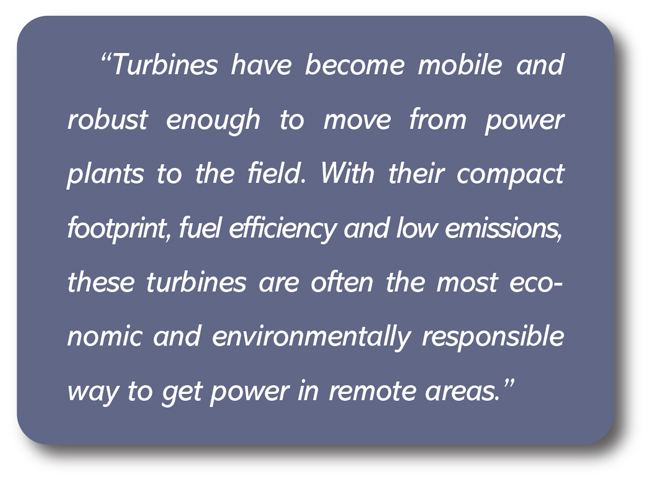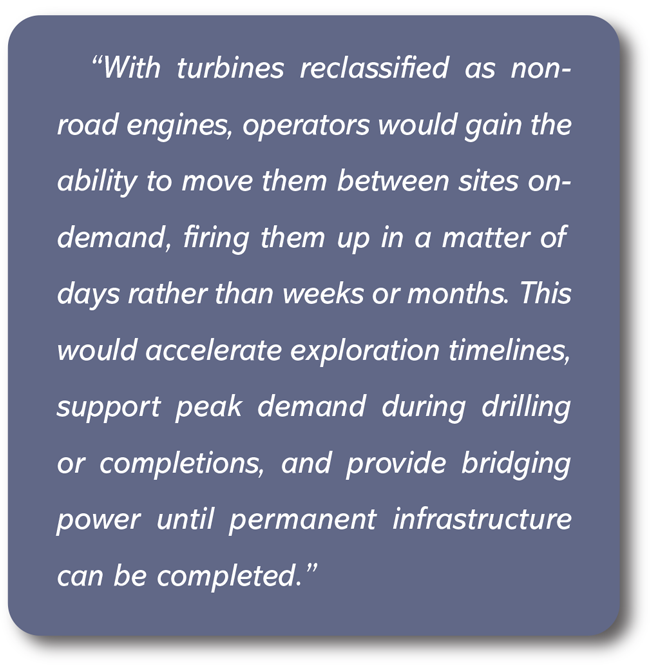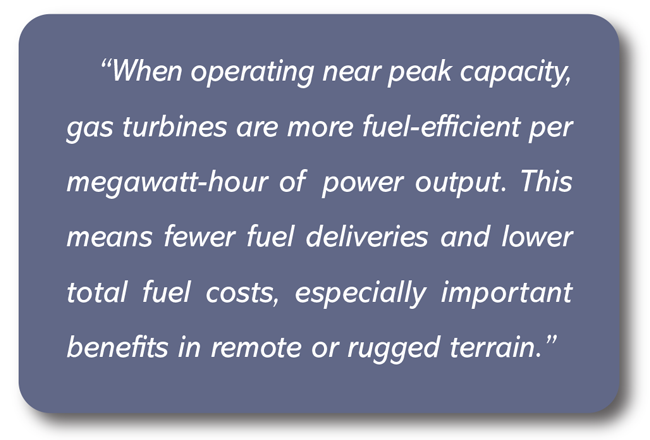
Modernizing Rules To Allow Mobile Turbines Would Ease Power Crunch
By Geoff Bland
Electric generators have become an increasingly important part of efficient oil field operations. They support everything from drilling rigs and hydraulic fracturing fleets to electric submersible pumps, compressors and gas processing plants.
Outside the oil field, portable generators allow economic expansion to outpace the grid by powering everything from data centers to domestic manufacturing. And when disaster strikes, the generators step in to help save lives.
Once, almost every portable generator would have been powered by a reciprocating engine. But today, turbines have become mobile and robust enough to move from power plants to the field. With their compact footprint, fuel efficiency and low emissions, these turbines are often the most economic and environmentally responsible way to get power in remote areas.
Unfortunately, outdated regulations are limiting the industry’s ability to leverage turbines. Under current rules, reciprocating internal combustion engines (RICE) are allowed to operate as “nonroad engines,” meaning they can move freely without triggering full air permitting requirements. However, portable turbines are still treated as stationary sources by federal regulations, even when they are performing the same function.
This might make sense if turbines had environmental impacts beyond those of RICE engines, but that is not the case. In fact, in many applications, especially ones that require high power density, turbines end up being cleaner as well as easier to deploy. They are treated differently not because that is logical, but through an accident of history that needs to be fixed.
To act as a voice for modernizing the regulations governing mobile power, the Coalition of Mobile Electric Turbine Users has formed as a national alliance of manufacturers, lessors and users of portable combustion turbines (PCTs). As one of our first acts, we have sent a petition to the U.S. Environmental Protection Agency requesting that it classify PCTs, like RICE, as nonroad engines when they are deployed temporarily.
This small legal change could yield massive energy, economic and environmental benefits by expanding access to electricity on the many locations where grid power is delayed, disrupted or unavailable.
Why It Matters
No industry stands to benefit more from this regulatory change than oil and gas—especially in the post-COVID, energy-rebuilding, AI-fueled era where construction timelines are tightening, energy demand is rising, and permitting backlogs are delaying projects across the country.
Drilling and fracing sites require high volumes of power, often in places with no utility access. Exploration and production companies need scalable, temporary power that can move from site to site.
As fields mature and the focus shifts to production, power remains essential. Even in areas with grid access, utility power can be too unreliable to depend on for essential production equipment, such as electric submersible pumps.
Meanwhile, stationary facilities such as liquefied natural gas export terminals, gas processing plants and pipelines face long delays in connecting to the grid. By providing power well ahead of that connection, turbines can prevent construction and startup delays that could cost facility operators millions.
Reliable power can also support the industry’s efforts to reduce emissions by enabling electrification of compressors and other equipment.
Despite the importance of mobile generation, the most efficient, powerful, and in many cases cleaner mobile energy option—portable gas turbines—is being held back by outdated permitting definitions. These turbines are ready to go. They just need a regulatory green light.
That is what COMET’s petition would provide: a fast-track to deploy mobile turbine power, legally and quickly, just like RICE engines already enjoy.
The Current Barrier
Today, portable combustion turbines face a regulatory barrier that portable RICE engines do not: ambiguity in the language of the Clean Air Act that causes mobile turbines in some locations to be considered stationary sources under EPA rules, which means they are subject to time-consuming and costly permitting processes. In contrast, RICE engines that remain at a location for less than 12 months are treated as nonroad engines and can be rapidly deployed without state or federal permitting hurdles.
For oil and gas projects—many of which are short-term by nature—this distinction makes a critical difference. Drilling and hydraulic fracturing do not generally require permitting for the power equipment because these operations take place before production. However, gas processing, oil production and other activities often occur in remote locations where grid power is unavailable. Portable combustion turbines, which can deliver up to 50 megawatts of power quickly and with a smaller operational footprint, are ideal for these operations.
Unfortunately, PCTs’ classification as stationary engines discourages their use by layering in permitting delays that can outlast the actual duration of the project. Obtaining permits can take months, which may be longer than the actual use of the turbine.
If approved, the COMET petition would remove this inefficiency, classifying PCTs as nonroad engines. This shift would unlock enormous value in oil and gas, where time is money and permitting delays can derail entire drilling campaigns. Given that reality, we hope many members of the industry will sign the petition.
With turbines reclassified as nonroad engines, operators would gain the ability to move them between sites on-demand, firing them up in a matter of days rather than weeks or months. This would accelerate exploration timelines, support peak demand during drilling or completions, and provide bridging power until permanent infrastructure can be completed.
In states that play a central role in U.S. oil and gas activity, such as Texas, North Dakota and New Mexico, this flexibility could translate into hundreds of millions of dollars in accelerated project delivery and avoided delays.
Environmental Benefits
One of the key advantages of combustion turbines over RICE engines is power density. While a typical RICE unit tops out at 2 to 3.5 MW, PCTs can generate 16.5–35 MW. That means one turbine can replace up to 12 RICE engines. In remote locations that need 30–60 MW to power pumps, hoists and control systems, this consolidation improves safety and efficiency by removing extra truckloads, accelerating setup, and significantly reducing operational complexity.
For example, a typical frac operation might require 30 diesel RICE generators, which take up space, consume manpower, and pose safety and maintenance risks. A single gas turbine can serve the same load while reducing noise, emissions and site footprint. This is especially critical in remote or environmentally sensitive areas, where logistics and local impact are major concerns.
Contrary to outdated assumptions, combustion turbines are often cleaner than RICE generators, particularly in high-load scenarios. Turbines tend to emit lower quantities of nitrogen oxides, volatile organic compounds and particulate matter, especially diesel particulate matter, which is a recognized carcinogen.
Additionally, turbines naturally generate wider and more dilute exhaust plumes due to their higher exhaust velocity and temperature. This lets emissions disperse more efficiently, reducing the likelihood of localized air quality issues, a particularly important advantage when operating near populated or environmentally sensitive areas.
From both an environmental and public health perspective, granting COMET’s petition would allow for cleaner energy delivery in oil and gas fields. It aligns with the Clean Air Act’s goals without undermining project timelines or industrial competitiveness.
Vital Bridge Power
One of the challenges faced by large oil and gas infrastructure projects—such as LNG terminals, gas processing plants, or pipeline pump stations—is the delay in connecting to grid power. Utility upgrades can take years, and in the meantime, these facilities sit idle or operate suboptimally.
Mobile gas turbines offer a powerful bridging solution. They can provide scalable, dispatchable power while waiting for permanent utility interconnection. By classifying these turbines as nonroad engines, COMET’s proposal allows operators to sidestep lengthy site-by-site permitting, offering a plug-and-play solution to one of the industry’s most persistent infrastructure constraints.
This “bridge to grid” approach is essential not only for initial construction but also for expansions, upgrades and repairs—all of which are common in the fast-paced oil and gas sector.
It’s possible to supply bridge power using RICE-based temporary power, but in many cases, turbines prove to be more affordable. Thanks to their power density, they can eliminate the complexity and cost that comes with synchronizing multiple engines, balancing loads, tracking each engine’s maintenance cycle and managing on- site technicians.
When operating near peak capacity, gas turbines are also more fuel-efficient per megawatt-hour of power output. This means fewer fuel deliveries and lower total fuel costs, especially important benefits in remote or rugged terrain.
By streamlining both capital and operational expenditures, the proposed regulatory change could yield significant savings for oil and gas companies over the lifecycle of a project.
Emergency Response
Oil and gas sites, whether upstream rigs, midstream pump stations, or downstream terminals, are all vulnerable to weather events, grid outages, and supply chain disruptions. Quick access to emergency power can make the difference between a safe shutdown and a catastrophic failure.
Because combustion turbines can be transported and activated rapidly, they are ideal for emergency use—but not under the current permitting structure. COMET’s petition would change that, allowing turbines to be staged and deployed without delay. This could prove invaluable in hurricane-prone areas such as the Gulf Coast, wildfire-threatened parts of California, or any location facing natural disaster risks.
Even in more mundane situations, updating the standards for mobile power could make a big difference. Oil and gas firms often operate under multiple regulatory regimes, and conflicting requirements lead to delays, fines or lawsuits. The current rules create an irrational discrepancy: a portable RICE engine used for temporary drilling is exempt from major air permitting, but a turbine doing the same job is not. This inconsistency stifles innovation and punishes companies trying to deploy cleaner, more efficient technologies.
By harmonizing the regulatory treatment of mobile power systems, the COMET petition brings clarity and predictability to project planning. It also fulfills multiple directives under recent Executive Orders aimed at reducing regulatory burdens, encouraging energy dominance, and restoring fair competition in the energy market.
Indeed, allowing easier deployment of portable turbines aligns with America’s broader strategic goals of energy independence and industrial innovation. By empowering domestic energy producers with better tools and fewer bureaucratic barriers, this regulatory update boosts resilience, increases competitiveness and accelerates modernization.
Just as fracing revolutionized oil and gas production two decades ago, streamlined portable power can enable the next generation of extraction and processing technologies. Whether it’s electrified drilling, AI-powered logistics, or zero-flare wellsite operations, portable combustion turbines are critical enablers—and the policy must catch up with the technology.
Big Impact
COMET’s petition represents more than a niche regulatory fix. It is a powerful catalyst for unlocking flexible, clean, and rapidly deployable energy solutions at a time when the oil and gas industry needs them most. In today’s landscape of high energy demand, constrained grid infrastructure, and increasingly rapid innovation in AI, data, and electrified industrial processes, the ability to mobilize power quickly and efficiently is no longer optional. It’s essential.
Oil and gas operators are navigating increasingly complex challenges: tight project timelines, remote site development, evolving environmental standards, and the rising cost of energy infrastructure delays. Portable combustion turbines are uniquely positioned to solve many of these issues, but only if regulatory barriers are lifted. COMET’s proposal delivers relief by reclassifying these turbines as nonroad engines, unlocking their full potential without compromising environmental safeguards.
This change isn’t about loosening standards. It’s about removing an outdated, illogical distinction that favors older, less efficient technologies over newer, cleaner, and more scalable ones. The current system rewards the use of dozens of small diesel engines over a single, lower-emission turbine simply because the rules have not kept pace with technology. That is not innovation. It’s inefficiency.
By adopting COMET’s proposed rule, the EPA can enable a smarter, faster, and more competitive energy future. It would free up essential capacity for drilling, fracing, LNG construction, pipeline buildouts, and mineral development. It would support emergency response in climate-vulnerable regions and provide a critical bridge for projects stuck in grid connection limbo. And it would signal that the federal government is serious about fair competition, energy independence, and pragmatic environmental stewardship.
Beyond oil and gas, the ripple effects would extend into data centers, manufacturing, mining, national defense, and any sector that relies on reliable, large-scale temporary power. It’s a foundational shift in how we deliver energy at the edge—cleaner, faster, and more effectively.
The infrastructure of the future cannot be built with the rules of the past. As the U.S. accelerates toward a more electrified economy, it must also modernize the frameworks that enable power delivery. COMET’s petition is a practical, immediate step toward that goal.
But like any petition, compelling logic alone cannot guarantee its success. Policymakers are far more likely to modernize the rules governing mobile power if they know that doing so has broad support. With that in mind, COMET urges oil and gas professionals who have faced power constraints to lend their voice to the cause by signing the petition.
Editor’s Note: COMET’s website, cometusa.org, has links for reading and signing the petition, which goes into more specifics on turbines’ strengths and the proposed regulatory changes. If readers would like more information about the petition or COMET, the author encourages them to call the organization’s steering committee at 337-224-2945.

GEOFF BLAND is the head of the steering committee for the Coalition of Mobile Electric Turbine Users and senior vice president of commercial strategy at Life Cycle Power. He has spent 18 years in power generation, including 15 years with Aggreko. During his career, Bland has designed and installed power plants across 70 countries. He is a tenured mechanical engineer with degrees from Glasgow University and Cambridge University.
For other great articles about exploration, drilling, completions and production, subscribe to The American Oil & Gas Reporter and bookmark www.aogr.com.



















